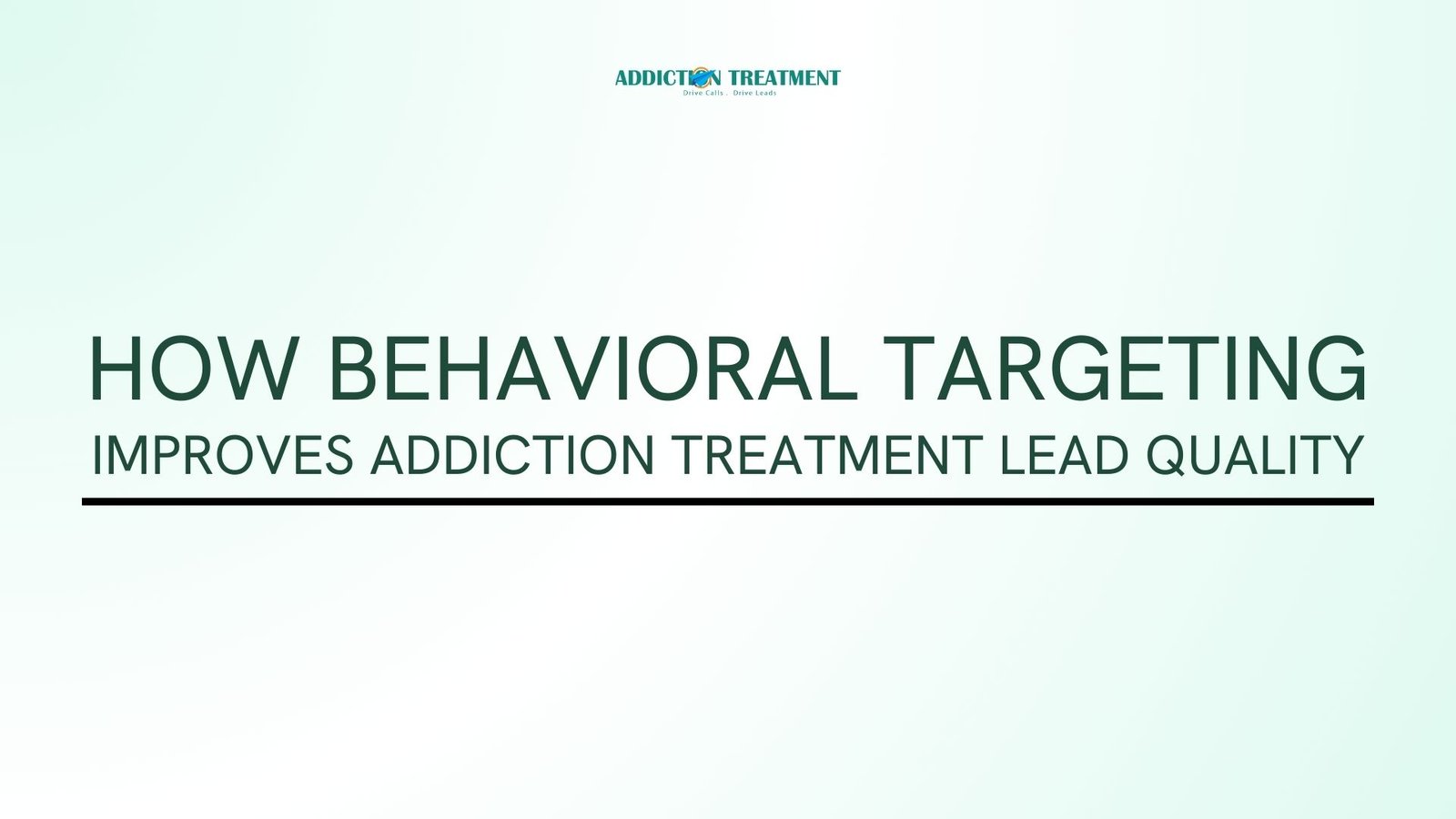In the highly sensitive field of addiction treatment marketing, attracting high-quality leads is a challenge that requires precision and empathy. Behavioral targeting has emerged as a powerful strategy to improve lead quality by focusing on the actions, interests, and needs of potential clients. By leveraging behavioral data, addiction treatment centers can ensure their marketing efforts are not only effective but also resonate deeply with individuals seeking help.
What Is Behavioral Targeting?
Behavioral targeting is a digital marketing strategy that uses data about a user’s online behavior to deliver personalized advertisements. This data includes:
- Web browsing history
- Search queries
- Time spent on specific pages
- Engagement with ads or emails
- Social media interactions
For addiction treatment centers, this approach enables targeting individuals who are actively seeking help, rather than casting a broad, generic net.
Why Behavioral Targeting Matters in Addiction Treatment
Unlike other industries, addiction treatment requires a highly nuanced approach to marketing. Behavioral targeting allows treatment centers to:
- Connect with the Right Audience: Focus on individuals showing clear signs of seeking help for addiction.
- Reduce Wasted Ad Spend: Avoid targeting irrelevant audiences by concentrating on high-intent users.
- Improve Conversion Rates: Personalize campaigns to address specific needs, making users more likely to take action.
Key Benefits of Behavioral Targeting for Addiction Treatment Lead Quality
1. High-Intent Audience Engagement
Behavioral targeting identifies users who are actively searching for addiction treatment-related information. By analyzing behaviors like search queries (e.g., “detox centers near me”), you can prioritize connecting with people who are ready to make a decision.
2. Personalized Messaging
Behavioral targeting enables tailored messaging based on user actions. For example, someone researching “inpatient vs. outpatient rehab” can be shown ads offering detailed guides on choosing the right treatment program.
3. Efficient Resource Allocation
Focusing on high-quality leads means less time and money wasted on uninterested or irrelevant audiences. Behavioral targeting ensures that every dollar spent on marketing delivers maximum impact.
How to Implement Behavioral Targeting in Addiction Treatment Marketing
1. Segment Your Audience
Segmentation is the backbone of effective behavioral targeting. Divide your audience into groups based on their actions and interests, such as:
- First-Time Visitors: People new to your site who may need introductory content.
- Repeat Visitors: Users who have browsed multiple pages but haven’t taken action.
- Converted Users: Leads who’ve already contacted you but haven’t enrolled in a program.
2. Leverage Analytics Tools
Use analytics platforms to track and understand user behavior. Tools like Google Analytics and Facebook Pixel can provide insights into:
- Which pages users visit most
- How long they stay on your site
- Which actions they take (e.g., form submissions, phone calls)
3. Use Dynamic Ad Retargeting
Retargeting is a critical component of behavioral targeting. Serve ads that align with the actions users have already taken:
- Visited Pages: If someone explored your “alcohol detox” page, show ads emphasizing your expertise in alcohol addiction treatment.
- Abandoned Forms: Retarget users who started but didn’t complete a form with ads encouraging them to finish.
4. Incorporate Email Campaigns
Behavioral targeting extends to email marketing as well. Create drip campaigns based on user actions:
- Trigger-Based Emails: Send follow-up emails when users download resources or attend webinars.
- Personalized Recommendations: Suggest programs or content based on previously visited pages or downloaded materials.
Examples of Behavioral Targeting in Action
1. Targeting Based on Search Queries
If a user searches for “affordable addiction treatment,” behavioral targeting can display ads emphasizing cost-effective options or free consultations.
2. Engagement with Social Media
Analyze interactions with posts or ads related to addiction treatment. Use this data to serve more relevant ads or guide users to helpful resources.
3. Lookalike Audiences
Platforms like Facebook allow you to create lookalike audiences based on the behavior of your existing leads. This expands your reach while maintaining quality.
Overcoming Challenges in Behavioral Targeting
While behavioral targeting is highly effective, it does come with challenges that require attention:
1. Compliance and Privacy Concerns
Addiction treatment marketing must adhere to strict regulations like HIPAA and advertising guidelines from platforms like Google and Facebook. Ensure:
- All data collection is consent-based.
- Personal information is anonymized and secure.
2. Avoiding Over-Targeting
Excessive retargeting can feel intrusive to users. Strike a balance by setting frequency caps on your ads and monitoring audience engagement.
3. Data Accuracy
Behavioral targeting relies on accurate data. Regularly audit your analytics tools to ensure the information you’re using is reliable.
Measuring Success in Behavioral Targeting Campaigns
To assess the effectiveness of your behavioral targeting efforts, track the following metrics:
- Conversion Rate: Measure how many users take desired actions, like filling out a contact form or making a phone call.
- Cost Per Lead (CPL): Determine how much you’re spending to acquire each lead.
- Bounce Rate: A lower bounce rate indicates that your targeted campaigns are engaging the right audience.
- Call Quality: Evaluate the duration and outcomes of phone calls generated through your campaigns.
Future Trends in Behavioral Targeting for Addiction Treatment
As technology evolves, behavioral targeting will become even more sophisticated:
1. AI-Powered Insights
AI and machine learning will enhance targeting by predicting user behavior and optimizing campaigns in real time.
2. Voice Search Adaptation
With the rise of voice search, targeting queries like “help for drug addiction near me” will become essential.
3. Cross-Device Targeting
Users often switch between devices during their research. Advanced behavioral targeting will track and adapt to this multi-device journey.
Conclusion
Behavioral targeting is transforming addiction treatment marketing by delivering high-quality leads through personalized and data-driven strategies. By understanding user actions and tailoring campaigns accordingly, treatment centers can improve lead quality while ensuring ethical and empathetic outreach. Implementing these strategies today will position your center for long-term success in connecting with those who need help the most.


Leave a Reply